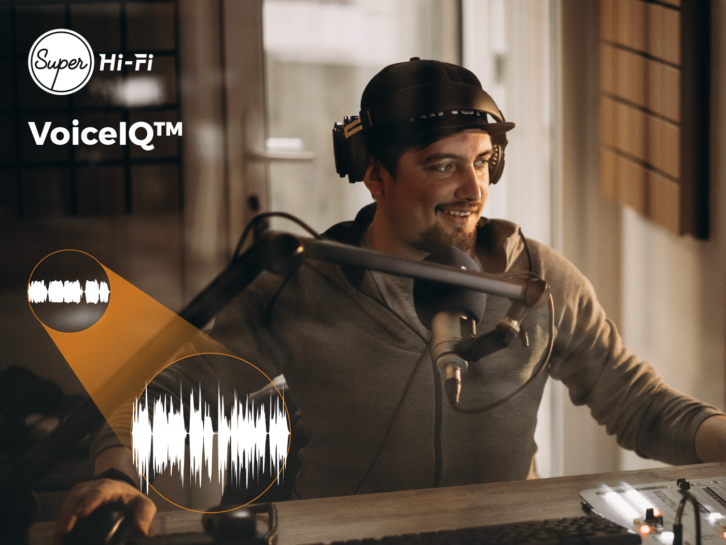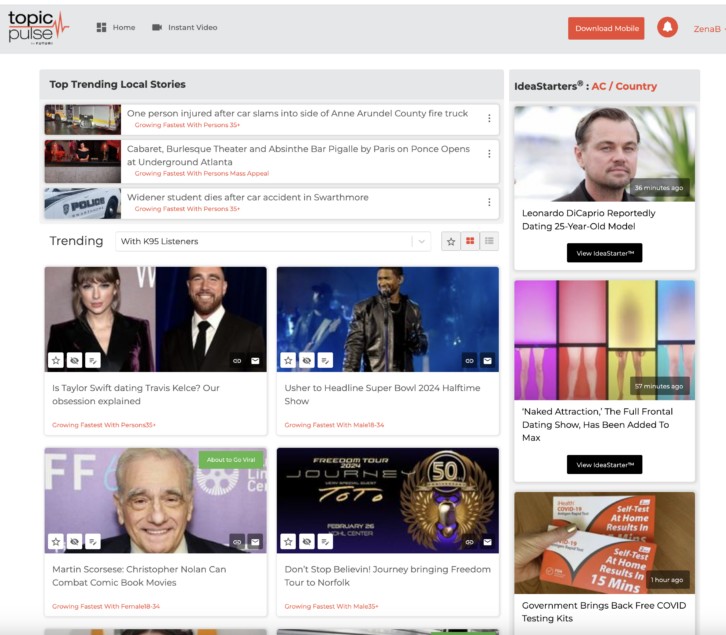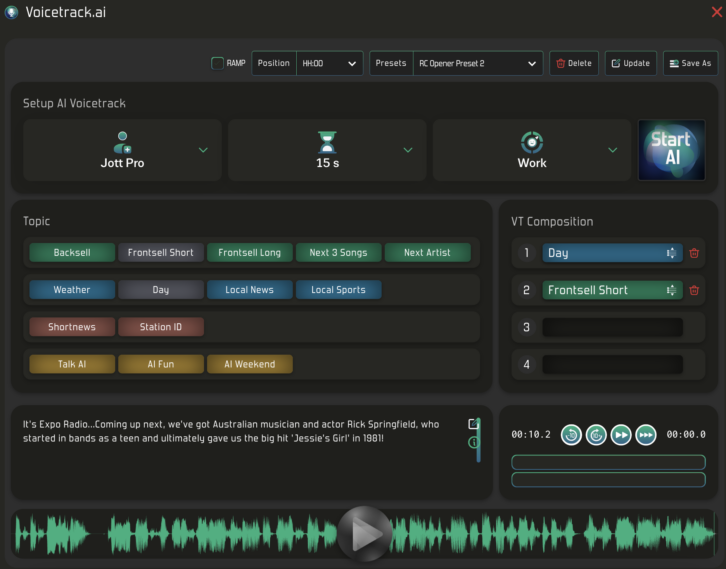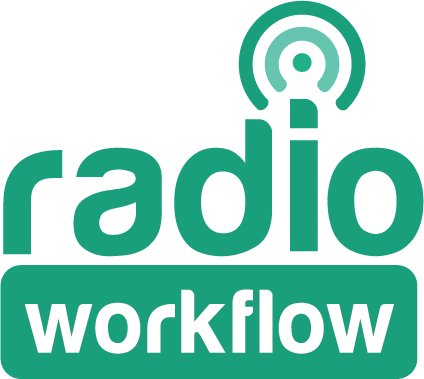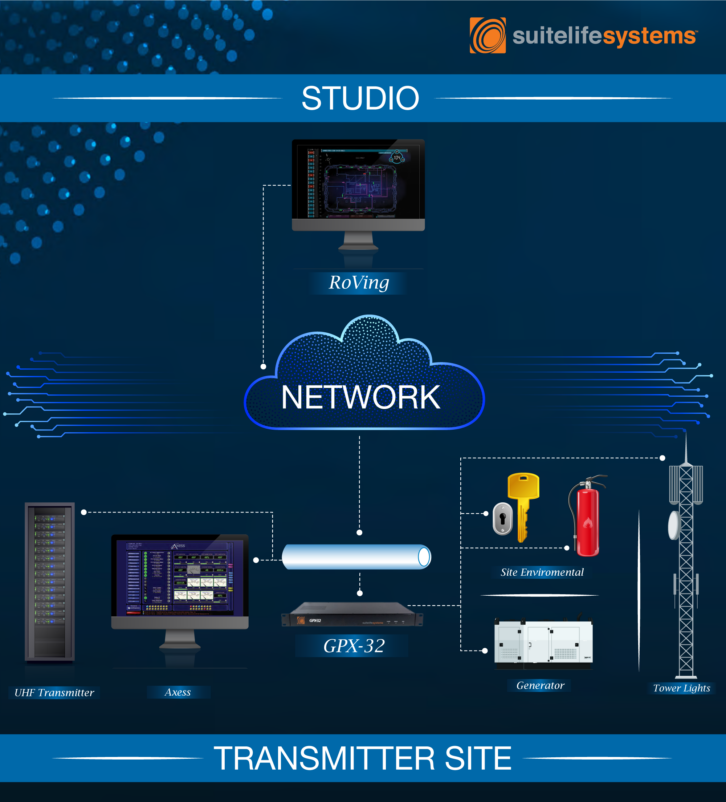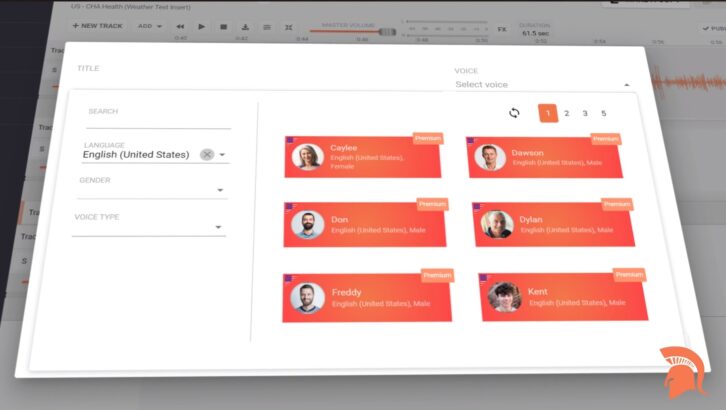1. SUPER HI-FI
Super Hi-Fi products are based on an AI production technology called MagicStitch, said Chief Commercial Officer Ryan Taylor.
The headliner product is Program Director, an “operating system” that Taylor says enables broadcasters to curate, program, schedule and operate their stations.
“AI powers all of the audio production, like creating segues, layering in voice tracks and branding, volume leveling and more. AI also powers our clock rotations, automatically selecting songs that sound good together and separating out music throughout the day.” Program Director is sold for a monthly platform or per-station fee.
The company also has Weathercaster, an automated service that can create weather reports using custom synthetic voices, produced with openers, sponsorships and music beds, and created in various lengths. The AI generates scripts, creates voices, assembles elements and produces the output. Weathercaster is offered in tiers starting at $199 per month per station.
And VoiceIQ, part of Program Director, is a cloud-based AI that prepares and delivers produced voice tracks. Taylor said they sound as if they were edited and mastered manually. It removes background noise, tone-matches to the user’s reference standard, eliminates plosives and clipping and optimizes dynamic range.
Super Hi-Fi’s audio and music selection/rotation AI was developed in house. The company uses ChatGPT for script creation and partners with ElevenLabs for voice synthesis. iHeartRadio is using MagicStitch for automated segues in its mobile apps on digital-only stations. Cardio equipment maker Peloton uses it on Peloton Radio and its “Scenic” rides. Sonos uses Program Director on its owned-and-operated stations.
2. FUTURI MEDIA
The company’s RadioGPT has gotten lots of headlines but that is only one of Futuri’s AI-based tools.
TopicPulse is an AI-driven story discovery and social content system. For show prep it promises “real-time insights on the stories that are currently trending with a specific audience, the stories that are about to go viral with that audience, and the stories that are getting stale so that content creators can avoid them.”
A companion product called TopicPulse Instant Video gives creators access to short video clips on that day’s hot stories, using licensed footage, that can be rebranded or edited with custom VO or images, and pushed to a station website and social feeds.
Spokeswoman Zena Burns said the AI is used to scan Facebook, Twitter/X, Instagram and a quarter of a million sources of news and information to deliver insights on how stories are performing with specific audiences. “AI is also used to create first drafts of social posts, blog posts and on-air talking points based on those stories.”
TopicPulse uses natural language processing and adaptive AI.
Futuri said the tool has thousands of users in radio, TV, digital publishing and other segments. Radio users include Audacy’s WXBK(FM) in New York and Hubbard’s WTOP and Howard University’s WHUR(FM), both in Washington.
Other tools from Futuri that rely on AI include SpotOn, Prep+, podcasting AI Post and revenue AI system TopLine.
3. WAYMARK
This video creation tool uses the website URL of a business to create “instant, fully customized and ready-to-air commercials.” It can be used to generate “spec” creative for potential ad partners for streaming and cable TV placements.
“Broadcasters find that this helps them from spec all the way to air; they can win more ad revenue and/or extend campaigns with local businesses,” said CEO Alex Persky-Stern.
“Our partners consistently report that Waymark helps open doors to businesses who otherwise would not have been able to afford video advertising packages.”
The platform uses AI for multiple stages of the video creation process. It incorporates large language models for scriptwriting, computer vision models for image curation and selection, upscaling models for asset enhancement, and text-to-speech technology for synthetic VOs. “Waymark leverages a fine-tuned model of GPT-3, as well as a proprietary combination of 12 other AI technologies.”
The company partners with stock libraries to ensure that its assets are licensed, and the AI models rely on images and videos that are already in use by the user’s brand.
Waymark is a scalable subscription-based service. Partners can choose monthly or annual payment plans. Radio clients include Alpha Media Group, Beasley Media Group and Morgan Murphy Media.
4. RADIO.CLOUD
From Radio.Cloud comes Voicetrack.ai, which is used to create hosted radio shows with an AI DJ.
“Voicetrack.ai allows a fully automated AI supported operation of a hosted 24/7 channel or complete radio shows, such as overnights or weekends,” said Managing Director/CEO Christian Brenner.
“The AI host will perform similarly to what a real DJ would do: music teasing, weather forecast, local stories, news, traffic reports, music chart updates, etc.”
AI creates the text for each voice break, creates DJ audio from a cloned voice and mixes the voice track into the show and playlist, including ramps and hook promos.
“We developed a complex backend and created the prompts we send to ChatGPT or Google Bard before checking and improving the reply,” Brenner said. “The Text-to-Speech is third-party.” Brenner called it “a real automated operation. We have heard that other products still require a lot of day-by-day manual work.”
The tool is sold as a monthly SaaS service, with cost varying depending on how many stations and how many hours per day are used.
In July Radio.Cloud helped launch Absolut Radio AI, believed to be the first 24/7 internet radio station fully driven by AI; the host, named kAI, informs listeners about AI and the voice tracks, imaging and playlist mixing are done by AI. Then in August, Absolut Radio AI debuted on DAB+, believed to be the first OTA station driven full-time by AI.
5. RADIO WORKFLOW
This is a web-based traffic platform that incorporates AI to generate creative elements for ad production. This includes voiceovers, voice cloning and generation, production music, sound effects and script writing.
Founder Shane Zammit said, “The AI component focuses on generative functions for ad production, including creating unique voiceovers through voice cloning and voice generation, script writing based on the context and tone of the ad segment, and generating production music and sound effects that fit the narrative.”
Zammit said Radio Workflow uses a mixture of AI models, including some developed in-house as well as open-source models and other external ones. “This hybrid approach allows us to offer a robust and versatile set of generative features tailored for radio ad production.”
The platform is available through a monthly model, with pricing tiers based on size and needs of the station.
Regional Media is among its users. “They have reported a significant improvement in the speed, productivity and creativity of their ad productions, attributing it to our AI-driven generative features,” Zammit said.
6. SUITELIFE SYSTEMS
SuiteLife Systems software helps broadcasters monitor infrastructure in and from studios and remote transmission sites. Its flagship product is Axess.
“It’s a logic engine that enables a centralized engineering team to monitor, control, manage and diagnose hardware and transmission infrastructure and facilities around the United States,” said Bobby Stevens, director of media technology sales and marketing.
“This includes monitoring for a site’s vital technical information including temperature, line pressure, RF Line (forward and reflective power), as well as the weather and outside environmental influences.”
The software provides cross-platform support for hardware and software systems made by various manufacturers. Axess logs data and creates instructions to notify engineers of changes in the state or function of infrastructure at their sites.
The engine uses SuiteLife Control Language to analyze hardware throughout a network. Data and information that are gathered are moved into an optical visual interface to be viewed on a dashboard. Axess notifies the broadcaster if systems are showing errors or are out of norm and logs the information. It can also be directed to make changes to hardware and RF transmission devices.
SuiteLife said Axess is used by major network affiliates and several large station groups, logging EAS and monitoring hundreds of sites and hardware.
7. Listen2.AI

Listen2.AI is transforming the news consumption landscape with its innovative personalized news podcast platform. Utilizing advanced AI, Listen2.AI delivers the latest information tailored to individual preferences and standards for unbiased, factual reporting. This platform is a boon for users who desire a hands-free, informed experience, offering news from various global sources directly to your ears.
Listen2.AI employs AI to curate and generate news content that matches the user’s interests, delivering it in an engaging audio format. Whether you’re commuting, exercising, or multitasking, Listen2.AI ensures you’re always connected to the world without needing to sift through multiple news sources.
Key Processes:
- Personalized News Feed: AI algorithms curate news based on your preferences, ensuring relevance and engagement.
- AI-Enhanced News Delivery: Sophisticated text-to-speech technology brings the news to life, offering a seamless listening experience.
- Comprehensive Content Moderation: AI monitors and moderates content to maintain quality and reliability.
- Diverse News Sources: Aggregates news from a wide range of reputable global sources to provide a well-rounded perspective.
With over 363,573 news podcasts already listened to, Listen2.AI stands out by offering a perpetually free service, making it accessible to everyone interested in staying informed without the hassle.
Ideal for busy professionals, news enthusiasts, and anyone looking to stay updated with minimal effort, Listen2.AI simplifies news consumption while maintaining a commitment to delivering factual, unbiased news.
8. ADTHOS
The Adthos Ad Platform can be used by broadcasters and clients to create targeted and voice-branded advertising and short-form audio content at a moment’s notice, the company says.
It uses AI to generate creative scripts. Text-to-speech adds the voicetrack using AI and synthetic voices, then the tool automatically selects music or sound effects to complete the audio ad, based on the context of the script generated.
Processes includes Voice Conversion, in which accent and pronunciation of the original speaker remain but it takes on the sound of the voice model; Overdubbing, in which a voice is instantly cloned and words in a sentence can be replaced, without training a voice model; Source Separation, in which music and voices can be separated into different tracks; Noise Removal, eliminating background noise; Speaker Separation, identifying individual speakers and separating them into tracks; and Content Moderation by the AI.
Adthos uses a combination of its own AI, open source with its own models, and external vendors. The company has approximately 70 trained voice models for broadcast purposes such as ads, news and sports.
An example of major users is Talpa Network in The Netherlands, which owns four national stations and sells airtime for four other national stations. Subscriptions start at just $49.95 per month for a basic package. A month’s free trial is available.
This year saw the launch of self-service audio ads. “Users simply submit a short briefing via the portal, and using AI technology, Adthos generates the script, adding AI voices, sound effects and music, resulting in a fully AI-produced ad that’s available to be played out instantly.”
For advertisers and smaller broadcasters, Adthos said, it saves time and cost of production, “while publishers can offer customers a self-service ad buying experience while supporting long-tail revenue streams through microtransactions.”

